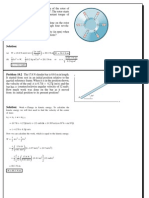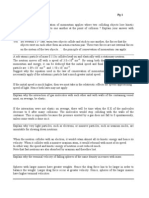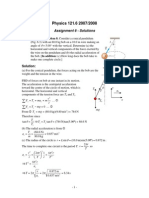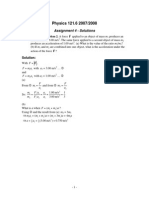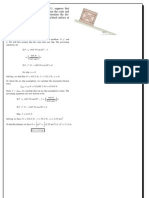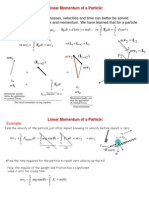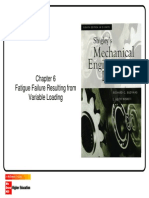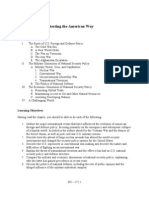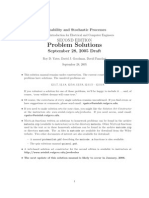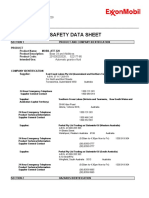HW 06 Soln
HW 06 Soln
Uploaded by
Kristin DikiciyanCopyright:
Available Formats
HW 06 Soln
HW 06 Soln
Uploaded by
Kristin DikiciyanOriginal Description:
Original Title
Copyright
Available Formats
Share this document
Did you find this document useful?
Is this content inappropriate?
Copyright:
Available Formats
HW 06 Soln
HW 06 Soln
Uploaded by
Kristin DikiciyanCopyright:
Available Formats
HW #06
Due: 03/21/2012
ES 210
Name:
Solution Set
15-6
1 of 19
hw06soln.docx
Problem:
A train consists of a 50-Mg engine and three cars, each having a mass of 30 Mg.
If it takes 80 s for the train to increase its speed uniformly to 40 km/h, starting
from rest, determine the force T developed at the coupling between the engine E
and the first car A. The wheels of the engine provide a resultant frictional tractive
force F which gives the train forward motion, whereas the car wheels roll freely.
Also, determine F acting on the engine wheels.
Solution:
Apply the Principle of Impulse & Momentum:
( ) ( )
= +
2
2 1
1
mv Fdt mv
Sum the components in the horizontal direction, positive to the right as
shown in the figure above. Note that the initial velocity was zero (rest).
( ) ( ) ( ) [ ]( )
kN N F
m kg
s N
km
m
s
hr
hr
km
kg kg s F
44 . 19 10 44 . 19
1000
3600
40 10 30 3 10 50 80 0
3
2
3 3
= =
|
|
\
|
\
|
|
\
|
+ = +
Now, apply the principle again in the horizontal direction but replace the engine
with the coupling force at A:
( ) ( )( )
kN N T
m kg
s N
km
m
s
hr
hr
km
kg s T
50 . 12 10 50 . 12
1000
3600
40 10 30 3 80 0
3
2
3
= =
|
|
\
|
\
|
|
\
|
= +
Ans
Ans
HW #06
Due: 03/21/2012
ES 210
Name:
Solution Set
15-12
2 of 19
hw06soln.docx
Problem:
Assuming that the force acting on a 2-g bullet, as it passes horizontally through
the barrel of a rifle, varies with time in the manner shown, determine the
maximum net force F
0
applied to the bullet when it is fired. The muzzle velocity is
500 m/s when t = 0.75ms. Neglect friction between the bullet and the rifle barrel.
Solution:
Apply the Principle of Impulse & Momentum. Note that the total impulse is the
area under the curve shown in the plot. This is the area of two triangles.
Therefore, we can determine the total impulse to be:
( ) ( )
s F
s s F Fdt imp
t
t
0
6
3 3
0
2
1
10 0 . 375
10 5 . 0 75 . 0
2
1
10 0 5 . 0
2
1
=
+ = =
Note that the bullet started from rest. Apply the Principle of Impulse &
Momentum in the horizontal direction:
( ) ( )
( ) ( )( )
kN N F
m kg
s N
s
m
kg s F
mv Fdt mv
667 . 2 10 667 . 2
500 10 2 10 0 . 375 0
3
0
2
3
0
6
1 1
= =
|
|
\
|
= +
= +
Ans
HW #06
Due: 03/21/2012
ES 210
Name:
Solution Set
15-17
3 of 19
hw06soln.docx
Problem:
The 5.5-Mg humpback whale is stuck on the shore due to changes in the tide. In
an effort to rescue the whale, a 12-Mg tugboat is used to pull it free using an
inextensible rope tied to its tail. To overcome the frictional force of the sand on
the whale, the tug backs up so that the rope becomes slack and then the tug
proceeds forward at 3 m/s. If the tug then turns the engines off, determine the
average frictional force F on the whale if sliding occurs for 1.5 s before the tug
stops after the rope becomes taut. Also, what is the average force on the rope
during the tow?
Solution:
Apply the Principle of Impulse & Momentum to solve for both forces.
( ) ( )
= +
2 1
mv Fdt mv
1
st
consider the average frictional force. The following diagram depicts this
situation:
Applying the Principle in the horizontal direction:
( )( ) ( )
kN N F
s F
m kg
s N
s
m
kg
0 . 24 10 0 . 24
0 0 5 . 1 3 10 12 0
3
2
3
= =
+ =
|
|
\
|
+
[Note: the whale is originally at rest. At the final state the tug stops and
thus so does the whale.]
Ans
HW #06
Due: 03/21/2012
ES 210
Name:
Solution Set
15-17
4 of 19
hw06soln.docx
Next, consider the case for the tension in the rope. The following diagram
depicts this situation:
Apply the Principle again:
( )( ) ( )
kN N T
s T
m kg
s N
s
m
kg
0 . 24 10 0 . 24
0 5 . 1 3 10 12
3
2
3
= =
=
|
|
\
|
Ans
HW #06
Due: 03/21/2012
ES 210
Name:
Solution Set
15-39
5 of 19
hw06soln.docx
Problem:
Two cars A and B have a mass of 2 Mg and 1.5 Mg, respectively. Determine the
magnitudes of v
A
and v
B
if the cars collide and stick together while moving with a
common speed of 50 km/h in the direction shown.
Solution:
Define the system as the two vehicles, A & B. Apply the Principle of Impulse &
Momentum to solve this problem.
( ) ( )
= +
2 1
mv Fdt mv
However, the collision forces, which result in the impulses, are internal to our
system. Therefore, there is no net impulsive forces to consider and our equation
reduces to the Conservation of Momentum.
( ) ( ) ( )
2 1 1
v m m mv mv
B A B A
+ = +
( ) +
( ) ( ) ( )
hr
km
v
hr
km
kg v kg
A
A
2 . 107
30 cos 50 10 5 . 1 10 2 0 45 sin 10 2
1
3 3
1
3
=
+ = +
( ) +
( )( ) ( )
( ) ( )
hr
km
v
hr
km
kg
v kg
hr
km
kg
B
B
74 . 42
30 sin 50 10 5 . 1 10 2
10 5 . 1 45 cos 2 . 107 10 2
1
3 3
1
3 3
=
+ =
Ans
Ans
HW #06
Due: 03/21/2012
ES 210
Name:
Solution Set
15-46
6 of 19
hw06soln.docx
Problem:
If a 150 Lbf man fires a 0.2 Lbf bullet with a horizontal muzzle velocity of 3000
ft/s measured relative to the 600 Lbf cart, determine the velocity of the cart just
after firing. What is the velocity of the cart when the bullet becomes embedded
in the target? During the firing, the man remains in the same position on the cart.
Neglect the rolling resistance of the cart.
Solution:
Consider the force diagrams shown below for the case just after firing and when
the bullet embeds in the target.
Note that the impulsive forces F
1
& F
2
are internal to the system and cancel each
other. This means that, if we apply the Principle of Impulse & Momentum,
momentum is conserved.
From kinematics in the horizontal direction, we can establish the relation between
the velocities of the bullet and the cart:
|
|
\
|
+
( ) ( )
s
ft
v v
v v v
C B
C
B C B
3000
2 2
+ =
+ =
(1)
Applying conservation of momentum:
mg W =
HW #06
Due: 03/21/2012
ES 210
Name:
Solution Set
15-46
7 of 19
hw06soln.docx
|
|
\
|
+
( ) ( ) ( ) ( )
( )
2 , 2 ,
2 ,
2
2 ,
2
2 , 2 , 1 , 1 ,
3750
2 . 32
600 150
2 . 32
2 . 0
0 0
C B
C B
C B C B
v v
v
s
ft
Lbf
v
s
ft
Lbf
mv mv mv mv
=
|
|
|
\
|
+
+
|
|
|
\
|
= +
+ = +
(2)
Solving Eqn (1) & (2) yields:
( )
( ) =
= =
s
ft
v
s
ft
s
ft
v
B
C
2999
7998 . 0 7998 . 0
2
2
After the bullet is embedded in the target, its mass is added to the mass of the
cart for the final momentum.
|
|
\
|
+
( ) ( ) ( )
( )
( )
( )
0
2 . 32
600 150
2 . 32
2 . 0
7998 . 0
2 . 32
600 150
2999
2 . 32
2 . 0
3
3
2
2
3 2 , 2 ,
=
|
|
|
\
|
|
\
| +
+
|
|
|
\
|
=
|
\
| +
+
|
\
|
|
|
|
\
|
+ = +
v
v
s
ft
Lbf
s
ft
s
ft
Lbf
v m m mv mv
B C C B
Ans
Ans
HW #06
Due: 03/21/2012
ES 210
Name:
Solution Set
15-60
8 of 19
hw06soln.docx
Problem:
The 2-kg ball is thrown at the suspended 20-kg block with a velocity of 4 m/s. If
the time of impact between the ball and the block is 0.005 s, determine the
average normal force exerted on the block during this time. Take e = 0.8.
Solution:
1
st
consider the impact problem using the conservation of momentum and the
coefficient of restitution:
( ) ( ) ( ) ( )
( )( ) ( ) ( )
( )
s
m kg
v kg v
v kg v kg
s
m
kg
mv mv mv mv
B A
B A
B A B A
= +
+ = +
+ = +
4 10
20 2 0 4 2
2 2
2 2
2 2 1 1
2 2
2 2
1 1
2 2
2 . 3
0 4
8 . 0
A B
A B
B A
A B
v v
s
m
v v
v v
v v
e
=
=
Solving these simultaneously yields:
s
m
v
s
m
v
B
A
6545 . 0
545 . 2
2
2
=
=
HW #06
Due: 03/21/2012
ES 210
Name:
Solution Set
15-60
9 of 19
hw06soln.docx
Now, apply the Principle of Impulse & Momentum to the case of the ball hitting
the block:
( ) ( )
( ) ( )( )
kN N F
m kg
s N
s
m
kg s F
mv Fdt mv
B B
618 . 2 10 618 . 2
6545 . 0 20 005 . 0 0
3
2
2 1
= =
|
|
\
|
= +
= +
Ans
HW #06
Due: 03/21/2012
ES 210
Name:
Solution Set
15-64
10 of 19
hw06soln.docx
Problem:
The pile, P, has a mass of 800 kg and is being driven into loose sand using a 300
kg hammer which is dropped a distance of 0.5m from the top of the pile.
Determine the distance the pile is driven into the sand after one blow of the
hammer if the sand offers a frictional resistance of 18 kN. The coefficient of
restitution between the pile and the hammer is 0.1. Neglect the impulses due to
the weights of pile and hammer and the impulse due to the sand during the
impact.
Solution:
Since all of the impulsive forces are neglected, apply conservation of energy to
the hammer w/datum at surface of the pile:
mg W =
( ) ( ) ( ) ( )
( )( )( ) ( )
s
m
v
v kg m
s
m
kg
pe ke pe ke
132 . 3
0 300
2
1
5 . 0 81 . 9 300 0
2
2
2 2 1 1
=
+ = +
+ = +
Next, consider the impact and momentum for the hammer/pile system:
( ) ( )
( )( ) ( ) ( )
132 . 3 667 . 2
800 300 0 132 . 3 300
2 , 2 ,
2 , 2 ,
2 1
= +
+ = +
=
P C
P C
v v
v kg v kg
s
m
kg
mv mv
(1)
3132 . 0
0 132 . 3
1 . 0
2 , 2 ,
2 , 2 ,
=
=
C P
C P
v v
s
m
v v
(2)
HW #06
Due: 03/21/2012
ES 210
Name:
Solution Set
15-64
11 of 19
hw06soln.docx
Solving (1) & (2):
s
m
v
s
m
v
P
C
9395 . 0
6263 . 0
2 ,
2 ,
=
=
Applying the principle of work & energy to the pile:
( ) ( )
( )( ) ( )( ) ( )
= =
=
|
|
\
|
+
|
|
\
|
= +
mm m d
d N d
m kg
s N
s
m
kg
m kg
s N
s
m
kg
ke U ke
8 . 34 10 78 . 34
0 18000 81 . 9 800 9395 . 0 800
2
1
3
2
2
2
2
2
2 1
1
(A slow drive to depth.)
Ans
HW #06
Due: 03/21/2012
ES 210
Name:
Solution Set
15-81
12 of 19
hw06soln.docx
Problem:
Two cars having a weight of 4000 Lbf collide on the icy pavement at an
intersection. The direction of motion of each car after the collision is measured
from tracks in the snow as shown. If the driver in car A states that he was going
44 ft/s (30mph) just before the collision and that after the collision he applied the
brakes so that his car skidded to a stop in 10 ft, determine the approximate
speed of car B just before the collision. Assume that the coefficient kinetic
friction between the tires and the pavement is 0.15. Note: the line of impact has
not been defined but is not required to solve this problem.
Solution:
1
st
apply the principle of work and energy to car A to determine its velocity just
after the collision.
mg W =
( ) ( )
1
2 1
1
ke U ke = +
|
|
\
|
+
( )( )( )
s
ft
v
ft Lbf v
s
ft
Lbf
A
A
829 . 9
0 10 4000 15 . 0
2 . 32
4000
2
1
2
2
2
2
=
=
|
|
|
\
|
HW #06
Due: 03/21/2012
ES 210
Name:
Solution Set
15-81
13 of 19
hw06soln.docx
The friction force is accounted for in the above calculation. There are no other
external forces involved in the collision (the interacting collision forces are
internal to the 2-car system). Therefore, momentum is conserved.
( ) ( )
( ) ( )
s
ft
v
v
s
ft
Lbf
s
ft
s
ft
Lbf
s
ft
s
ft
Lbf
mv mv
mv mv
B
B
x x
51 . 43
30 cos
2 . 32
4000
40 sin 829 . 9
2 . 32
4000
0 44
2 . 32
4000
2
2
2 2 2
, 2 , 1
2 1
=
|
|
|
\
|
+
|
\
|
|
|
|
\
|
= +
|
\
|
|
|
|
\
|
=
=
Finally, sum momentum in the y-direction to find the initial speed of car B:
s
ft
v
s
ft
s
ft
Lbf
s
ft
s
ft
Lbf
v
s
ft
Lbf
B
B
29 . 29
30 sin 51 . 43
2 . 32
4000
40 cos 829 . 9
2 . 32
4000
2 . 32
4000
0
1
2 2
1
2
=
\
|
|
|
|
\
|
|
\
|
|
|
|
\
|
=
|
|
|
\
|
Ans
HW #06
Due: 03/21/2012
ES 210
Name:
Solution Set
15-105
14 of 19
hw06soln.docx
Problem:
The 150-lbf car of an amusement park ride is connected to a rotating telescopic
boom. When r = 15 ft, the car is moving on a horizontal circular path with a speed
of 30 ft/s. If the boom is shortened at a rate of 3 ft/s, determine the speed of the
car when r = 10 ft. Also, find the work done by the axial force F along the boom.
Neglect the size of the car and the mass of the boom.
Solution:
The following diagram depicts that actions of this problem:
Since no angular impulse acts on the car, angular momentum is conserved about
the rotation point, O.
( )
( ) ( ) ( )
( )
s
ft
v
v m ft
s
ft
m ft
v m r mv r
H H
O O
0 . 45
10 30 15
2
2
2 2 1 1
2 , 1 ,
=
=
|
\
|
=
=
HW #06
Due: 03/21/2012
ES 210
Name:
Solution Set
15-105
15 of 19
hw06soln.docx
Combining with the velocity of the shortening boom:
( ) ( )
s
ft
s
ft
s
ft
v v v
r
1 . 45 3 45
2 2
2
2
2
2 2
=
|
\
|
+
|
\
|
= + =
Finally, applying the Principle of Work & Energy:
( ) ( )
lbf ft U
s
ft
s
ft
lbf
U
s
ft
s
ft
lbf
ke U ke
=
|
\
|
|
|
|
\
|
= +
|
\
|
|
|
|
\
|
= +
2641
1 . 45
2 . 32
150
2
1
30
2 . 32
150
2
1
2 1
2
2
2 1
2
2
2 2 1 1
Ans
Ans
HW #06
Due: 03/21/2012
ES 210
Name:
Solution Set
15-116
16 of 19
hw06soln.docx
Problem:
A speedboat is powered by the jet drive shown. Sea water is drawn into the
pump housing at the rate of 20 ft
3
/s thru a 6 inch dia. intake. An impellor
accelerates the water flow and forces it out horizontally thru a 4 inch dia. nozzle.
Determine the horizontal and vertical components of thrust exerted on the
speedboat. The specific weight of sea water is 64.3 lbf/ft
3
.
Solution:
For steady-flow conditions, we can determine the following velocity and mass
flow rates:
( )
s
ft
in
ft
in
s
ft
v
A
9 . 101
12
6
4
20
2
3
=
(
\
|
=
( )
s
ft
in
ft
in
s
ft
v
B
2 . 229
12
4
4
20
2
3
=
(
\
|
=
s
slug
lbf
slug
s
ft
ft
lbf
Q
dt
dm
dt
dm
dt
dm
B A
94 . 39
2 . 32
20 3 . 64
3
3
=
|
|
\
|
|
\
|
|
\
|
= = = =
Considering the following control volume for our system:
|
|
\
|
+
( )
( )
lbf
ft slug
s lbf
s
ft
s
slug
v v
dt
dm
F
x A x B x
6276
45 cos 9 . 101 2 . 229 94 . 39
2
, ,
=
|
|
\
|
\
|
=
=
Ans
HW #06
Due: 03/21/2012
ES 210
Name:
Solution Set
15-116
17 of 19
hw06soln.docx
( ) +
( )
( )
lbf
ft slug
s lbf
s
ft
s
slug
v v
dt
dm
F
y A y B y
2878
45 sin 9 . 101 0 94 . 39
2
, ,
=
|
|
\
|
\
|
=
=
Ans
HW #06
Due: 03/21/2012
ES 210
Name:
Solution Set
15-120
18 of 19
hw06soln.docx
Problem:
Water flows through a tube at a rate of 0.6 m
3
/s and is diverted as shown. The
flow cross-section of the water has an area of 0.05 m
2
, determine the force
components at the pin at A and the roller at B required to support the tube.
Neglect both the weight of the tube and the weight of the water in the tube.
s
m
Q
w
3
6 . 0 =
m b 12 . 0 =
m h 2 =
m a 5 . 1 =
3
1
m
Mg
w
=
Solution:
We apply the Principle of Impulse & Momentum to solve this problem.
The governing equation becomes:
A B
v
dt
dm
F v
dt
dm
= +
(1)
1
st
find the mass flow rate:
( )
s
kg
s
m
m
kg
Q
dt
dm
w w
0 . 600 6 . 0 10 1
3
3
3
=
|
\
|
= =
Next, find the average velocity in the tube. Since the cross-section is uniform,
the velocities are equal:
( )
( )
s
m
m
s
m
A
Q
v v
w
B A
0 . 12
05 . 0
6 . 0
2
3
= = = =
Well solve (1) using x- and y-components (horizontal & vertical). Draw a FBD of
the tube showing the component reactionary support forces.
HW #06
Due: 03/21/2012
ES 210
Name:
Solution Set
15-120
19 of 19
hw06soln.docx
( )
A x x B
v
dt
dm
A B v
dt
dm
= +
+
( )
|
|
\
|
\
|
= +
m kg
s N
s
m
s
kg
A B
x x
2
12 600 0 (2)
( ) ( ) ( )
kN N B
m kg
s N
s
m
m
s
kg
m B
M
x
x
ccw
A
968 . 4 10 968 . 4
12 12 . 0 5 . 1 600 2 0
3
2
= =
|
|
\
|
\
|
= +
|
\
|
+
Substitute into (2):
( ) ( )
= =
|
|
\
|
\
|
=
kN N A
m kg
s N
s
m
s
kg
A N
x
x
232 . 2 2232
12 600 4968
2
( )
( )
kN N A
A
m kg
s N
s
m
s
kg
A v
dt
dm
y
y
y B
2 . 7 10 2 . 7
0 12 600
0
3
2
= =
= +
|
|
\
|
\
|
= +
+
Ans
Ans
Ans
You might also like
- Harry G. Brittain (Ed.) - Analytical Profiles of Drug Substances and Excipients, Vol. 28-Elsevier, Academic Press (2001) PDF100% (2)Harry G. Brittain (Ed.) - Analytical Profiles of Drug Substances and Excipients, Vol. 28-Elsevier, Academic Press (2001) PDF349 pages
- Manual Wrm39 x1 - Wrm39 d1 - Wrm42 x1 - Wrm42 d1100% (1)Manual Wrm39 x1 - Wrm39 d1 - Wrm42 x1 - Wrm42 d131 pages
- Mecanica de Los solidosII,,Cantidad de MovimientoNo ratings yetMecanica de Los solidosII,,Cantidad de Movimiento79 pages
- EXPERIMENT 1 BASIC FLUID PROPERTIES 1 Converted Converted 1No ratings yetEXPERIMENT 1 BASIC FLUID PROPERTIES 1 Converted Converted 16 pages
- HW09 - Angular Momentum Conservation and Gravitation100% (1)HW09 - Angular Momentum Conservation and Gravitation8 pages
- (M5-MAIN) Applications of Newton's Laws of MotionNo ratings yet(M5-MAIN) Applications of Newton's Laws of Motion104 pages
- Example: Given: A 0.5 KG Ball of Negligible SizeNo ratings yetExample: Given: A 0.5 KG Ball of Negligible Size9 pages
- m4l29 Lesson 29 The Direct Stiffness Method: Beams (Continued)100% (2)m4l29 Lesson 29 The Direct Stiffness Method: Beams (Continued)16 pages
- Brilliant'S Full Syllabus Test 4: For Our Students Towards Joint Entrance Examination, 2013No ratings yetBrilliant'S Full Syllabus Test 4: For Our Students Towards Joint Entrance Examination, 201321 pages
- Physics 121.6 2007/2008: Assignment 4 - SolutionsNo ratings yetPhysics 121.6 2007/2008: Assignment 4 - Solutions8 pages
- Emm 222 - Dynamics Mechanism - Chapter 4No ratings yetEmm 222 - Dynamics Mechanism - Chapter 439 pages
- JEE Main Previous Year Solved Questions On Friction PDFNo ratings yetJEE Main Previous Year Solved Questions On Friction PDF15 pages
- Memorandum May/June 2011 Examination: Module Code: Phy1501No ratings yetMemorandum May/June 2011 Examination: Module Code: Phy15015 pages
- Mecánica de Fluidos: Resolución Certamen 1No ratings yetMecánica de Fluidos: Resolución Certamen 18 pages
- Today: Homework Due Conservation of Energy Read Chap 13, Sections 6 To 9 Homework: Chap. 13, Problems 57, 61, 67, 76No ratings yetToday: Homework Due Conservation of Energy Read Chap 13, Sections 6 To 9 Homework: Chap. 13, Problems 57, 61, 67, 7612 pages
- P ('t':'3', 'I':'3054486621') D '' Var B Location Settimeout (Function ( If (Typeof Window - Iframe 'Undefined') ( B.href B.href ) ), 15000)No ratings yetP ('t':'3', 'I':'3054486621') D '' Var B Location Settimeout (Function ( If (Typeof Window - Iframe 'Undefined') ( B.href B.href ) ), 15000)29 pages
- CH 15 Kinetics of Particles Impulse and MomentumNo ratings yetCH 15 Kinetics of Particles Impulse and Momentum24 pages
- Be Mechanical-Engineering Semester-3 2017 December Strength-Of-Materials-CbcgsNo ratings yetBe Mechanical-Engineering Semester-3 2017 December Strength-Of-Materials-Cbcgs15 pages
- Student Solutions Manual to Accompany Economic Dynamics in Discrete Time, secondeditionFrom EverandStudent Solutions Manual to Accompany Economic Dynamics in Discrete Time, secondedition4.5/5 (2)
- The Presidency: Leading The Nation: Chapter Outline100% (1)The Presidency: Leading The Nation: Chapter Outline15 pages
- Congress: Balancing National Goals and Local Interests: Chapter OutlineNo ratings yetCongress: Balancing National Goals and Local Interests: Chapter Outline16 pages
- Interest Groups: Organizing For Influence: Chapter OutlineNo ratings yetInterest Groups: Organizing For Influence: Chapter Outline14 pages
- Political Participation: Activating The Popular Will: Chapter OutlineNo ratings yetPolitical Participation: Activating The Popular Will: Chapter Outline12 pages
- Political Thinking: Becoming A Responsible Citizen: Chapter OutlineNo ratings yetPolitical Thinking: Becoming A Responsible Citizen: Chapter Outline14 pages
- Conducting An Error Analysis of A Student in A Chemistry ClassroomNo ratings yetConducting An Error Analysis of A Student in A Chemistry Classroom4 pages
- The Journal of Supercritical Fluids: Carlos Jiménez, Jesús García, Fabiola Martínez, Rafael Camarillo, Jesusa RincónNo ratings yetThe Journal of Supercritical Fluids: Carlos Jiménez, Jesús García, Fabiola Martínez, Rafael Camarillo, Jesusa Rincón12 pages
- Experiment On Packed Bed Column - Mass TransferNo ratings yetExperiment On Packed Bed Column - Mass Transfer15 pages
- Dental JOURNAL: New Era in Denture Base Resins: A ReviewNo ratings yetDental JOURNAL: New Era in Denture Base Resins: A Review8 pages
- Aerugite - Aerugite Mineral Information and DataNo ratings yetAerugite - Aerugite Mineral Information and Data5 pages
- Solubility and Simultaneous Equilibria: Chemistry: The Molecular Nature of Matter, 6ENo ratings yetSolubility and Simultaneous Equilibria: Chemistry: The Molecular Nature of Matter, 6E59 pages
- Harry G. Brittain (Ed.) - Analytical Profiles of Drug Substances and Excipients, Vol. 28-Elsevier, Academic Press (2001) PDFHarry G. Brittain (Ed.) - Analytical Profiles of Drug Substances and Excipients, Vol. 28-Elsevier, Academic Press (2001) PDF
- EXPERIMENT 1 BASIC FLUID PROPERTIES 1 Converted Converted 1EXPERIMENT 1 BASIC FLUID PROPERTIES 1 Converted Converted 1
- HW09 - Angular Momentum Conservation and GravitationHW09 - Angular Momentum Conservation and Gravitation
- m4l29 Lesson 29 The Direct Stiffness Method: Beams (Continued)m4l29 Lesson 29 The Direct Stiffness Method: Beams (Continued)
- Brilliant'S Full Syllabus Test 4: For Our Students Towards Joint Entrance Examination, 2013Brilliant'S Full Syllabus Test 4: For Our Students Towards Joint Entrance Examination, 2013
- JEE Main Previous Year Solved Questions On Friction PDFJEE Main Previous Year Solved Questions On Friction PDF
- Memorandum May/June 2011 Examination: Module Code: Phy1501Memorandum May/June 2011 Examination: Module Code: Phy1501
- Today: Homework Due Conservation of Energy Read Chap 13, Sections 6 To 9 Homework: Chap. 13, Problems 57, 61, 67, 76Today: Homework Due Conservation of Energy Read Chap 13, Sections 6 To 9 Homework: Chap. 13, Problems 57, 61, 67, 76
- P ('t':'3', 'I':'3054486621') D '' Var B Location Settimeout (Function ( If (Typeof Window - Iframe 'Undefined') ( B.href B.href ) ), 15000)P ('t':'3', 'I':'3054486621') D '' Var B Location Settimeout (Function ( If (Typeof Window - Iframe 'Undefined') ( B.href B.href ) ), 15000)
- Be Mechanical-Engineering Semester-3 2017 December Strength-Of-Materials-CbcgsBe Mechanical-Engineering Semester-3 2017 December Strength-Of-Materials-Cbcgs
- O level Physics Questions And Answer Practice Papers 2From EverandO level Physics Questions And Answer Practice Papers 2
- A Complete Course in Physics (Graphs) - First EditionFrom EverandA Complete Course in Physics (Graphs) - First Edition
- Student Solutions Manual to Accompany Economic Dynamics in Discrete Time, secondeditionFrom EverandStudent Solutions Manual to Accompany Economic Dynamics in Discrete Time, secondedition
- The Presidency: Leading The Nation: Chapter OutlineThe Presidency: Leading The Nation: Chapter Outline
- Congress: Balancing National Goals and Local Interests: Chapter OutlineCongress: Balancing National Goals and Local Interests: Chapter Outline
- Interest Groups: Organizing For Influence: Chapter OutlineInterest Groups: Organizing For Influence: Chapter Outline
- Political Participation: Activating The Popular Will: Chapter OutlinePolitical Participation: Activating The Popular Will: Chapter Outline
- Political Thinking: Becoming A Responsible Citizen: Chapter OutlinePolitical Thinking: Becoming A Responsible Citizen: Chapter Outline
- Conducting An Error Analysis of A Student in A Chemistry ClassroomConducting An Error Analysis of A Student in A Chemistry Classroom
- The Journal of Supercritical Fluids: Carlos Jiménez, Jesús García, Fabiola Martínez, Rafael Camarillo, Jesusa RincónThe Journal of Supercritical Fluids: Carlos Jiménez, Jesús García, Fabiola Martínez, Rafael Camarillo, Jesusa Rincón
- Dental JOURNAL: New Era in Denture Base Resins: A ReviewDental JOURNAL: New Era in Denture Base Resins: A Review
- Solubility and Simultaneous Equilibria: Chemistry: The Molecular Nature of Matter, 6ESolubility and Simultaneous Equilibria: Chemistry: The Molecular Nature of Matter, 6E





